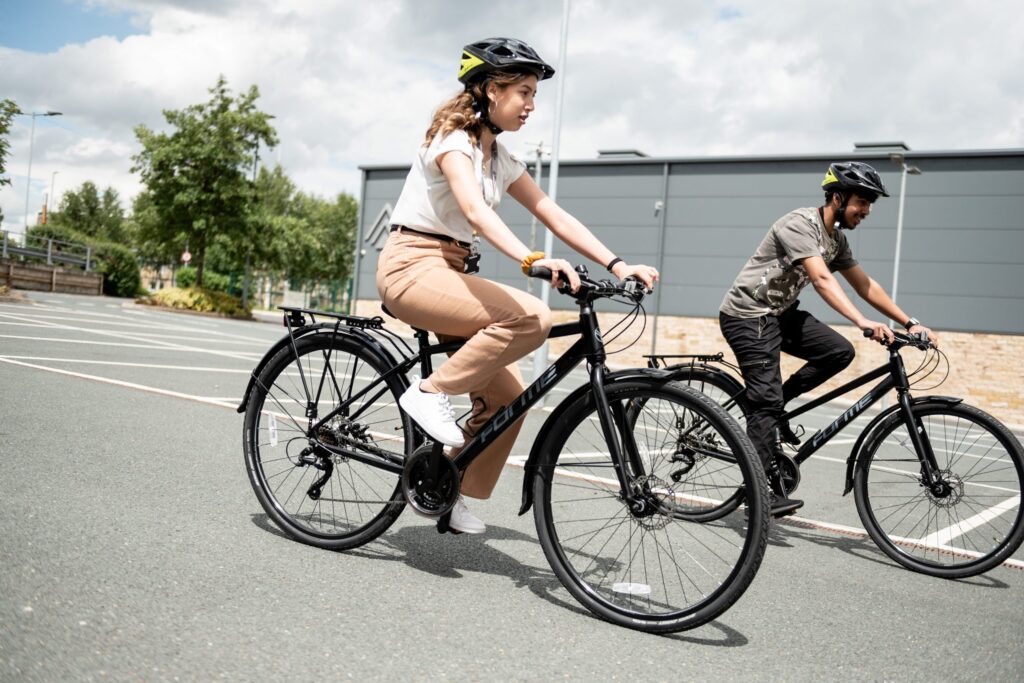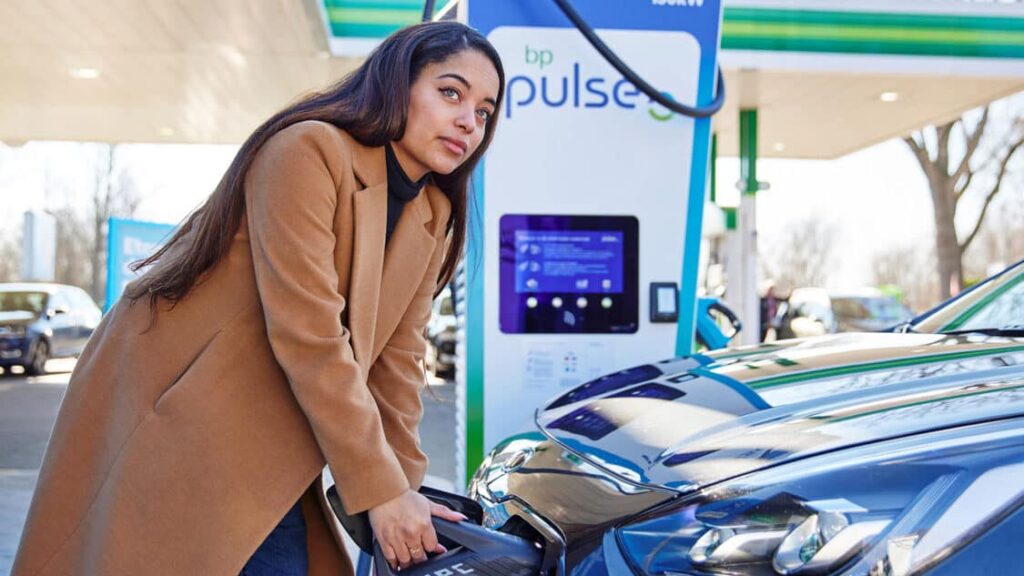Michigan strives to be a mobility leader, but largely ignores any non-car mobility. We need a truly modern transportation system that provides affordable, accessible, climate-friendly options for everyone while prioritizing walking, rolling, transit, and zero-emission union-made vehicles
We all want vibrant communities where kids can play and families can thrive. Strong communities where people want to live, work, shop, and play must offer ways for everyone to get around that are affordable, reliable, clean, and accessible.
Envision the Future

Imagine the life of a Michigan family of five. Dad walks with their daughter to school, then takes rapid transit to work. Mom works from home in the morning before renting an EV car-share for a few hours to take Grandma to a doctor’s appointment and pick up some bulky items from Costco before picking up their daughter from school. Their teenage son bikes to school and his after-school job, then meets up with friends for a study group before taking the bus home.
After her appointment, Grandma gets a paratransit ride to the senior center for her yoga class and her volunteer tutoring. To get some fresh air and exercise, Dad rents an e-bike to ride home with a stop at the market. After dinner, Mom catches the bus to meet her sister at the train station, in from Toronto for a few days, and they go out for a few drinks, grabbing an Uber home.
Five people, all able to do all the things a busy family needs and wants to do, and with the money they save by not paying for multiple cars, they save up for great vacations, college, and retirement.
Unfortunately, too few Michigan families have all those options for getting around. For decades, Michigan’s mobility investments have focused almost exclusively on cars, gas, roads, and highways. It’s time for Michigan to rebalance our transportation system to ensure all Michiganders have the range of affordable, accessible, clean mobility options that enable vibrant communities.

The Problem
Lack of Mobility Options Exclude or Harm Too Many Michiganders
- Over one thousand Michiganders are killed on our roads every year and it’s not improving.
- Not everyone drives, yet non-car travel is too often inconvenient or even impossible.
- Seniors need mobility options when they retire from driving.
- People with disabilities lack affordable alternatives.
- People willing to work often can’t access job opportunities.
- Driving is expensive – averaging $12,000 a year!
- Transportation pollutes our air, water, and climate.
- Car-centric design spurs traffic congestion, sprawl, poor health, and loneliness.
It’s time to build our communities around the needs of all people!

The Solution
Affordable, Sustainable Mobility Choices that Work for Everyone
There is no single transportation mode that works well for everyone or in every situation. It’s time for Michigan to diversify our mobility to prioritize walking, rolling, biking, transit, shared mobility, and electric mobility.
- Prioritize Walking and Biking
- Walking should be a primary mode of mobility that is safe and convenient for many trips, with destinations built closer together and wide sidewalks that are safe and accessible for wheelchair users and those pushing strollers.
- Bicycling should be prioritized as a serious way of getting around, with well-marked protected bike lanes that are comfortable to people of all ages and abilities.
- Make a Wide Range of Transit Broadly Available
- Passenger trains and intercity coach buses should provide easy, reliable travel between cities across metro regions, across Michigan, and across the Midwest.
- Rapid transit should move a lot of people quickly along the busiest and densest roads, running every 5-10 minutes at speeds similar to driving – whether light rail to spur economic development or bus rapid transit at lower construction costs.
- Traditional buses are the lifeblood of the transit system, reliably and affordably getting people along consistent routes every day.
- Dial-a-ride provides critical connections for people with disabilities and in low-density communities. Rides are requested a few days ahead of time and provided curb-to-curb in a shared van or small bus.
- On-demand rides can be a useful supplement, taking people a few miles within an hour of their request.
- Shared Mobility and Electric Cars
- Carpooling, car rentals, car share systems, and ride-hailing services like Uber and Lyft can all enhance mobility for occasional needs without the high costs and negative impacts of personal car ownership.
- Electrify whenever possible. While personal cars will remain part of the mobility ecosystem, electric vehicles are a cleaner and less noisy alternative to regular gas cars. This requires convenient affordable and accessible charging infrastructure to be broadly available.
- Autonomous and connected vehicles may be useful supplements especially as shared shuttles along regular routes, but are not a silver bullet solution to most transportation problems. They must be held to high safety standards in real-world situations, especially for people outside the vehicle.

Policy Pathways
Today’s transportation is the result of decisions made by decades of politicians and planners. We can create the transportation system we want, if Michigan’s leaders make thoughtful strategic decisions that truly prioritize access, opportunity, safety, and health.

- Invest in options
- Michigan must invest $1 billion a year in transit, rail, and other non-car transportation to provide convenient travel within and between cities.
- Metro regions must invest in regional transit that frequently and conveniently connects communities, enabled by dedicated regional transit funding.
- Reprioritize transportation spending
- Transportation agencies should transparently quantify and compare the impacts of proposed transportation projects, evaluating not only their impact on congestion and pavement quality but also on safety, accessibility, pollution, and other state values.
- Spending on road-widening projects induces greater travel demand but seldom decreases travel times, so should be avoided whenever possible.
- Prioritize safety for all
- Roads must be designed to recognize the needs of all users, making space for safe walking, biking, and rolling with wider sidewalks, dedicated bike lanes, and narrow car lanes.
- Plan multimodal
- Time to stop making transportation decisions is silos. When repaving roads, transportation decision-makers must consider where and how to add bike or bus lanes, crosswalks, wider sidewalks, and EV charging.
- Enable EVs
- Invest in EV car-share systems and affordable charging infrastructure in public spaces.
- Land use reforms
- Leaders across Michigan should adopt policies to eliminate parking minimum requirements (except accessible parking) and to increase housing density, especially near transit.
